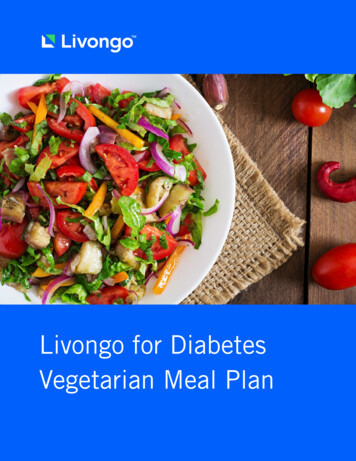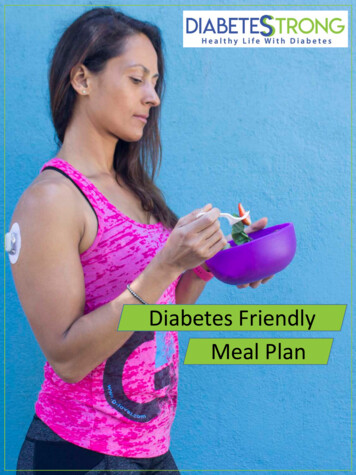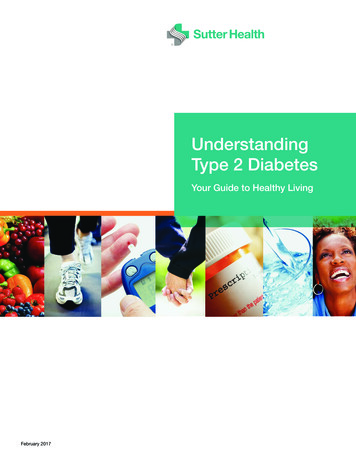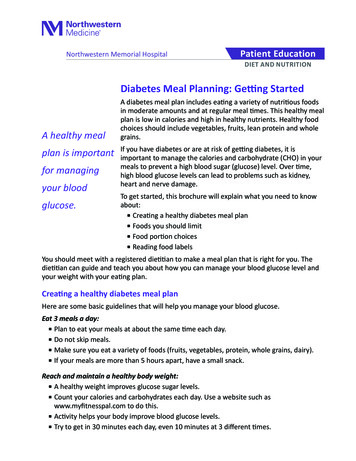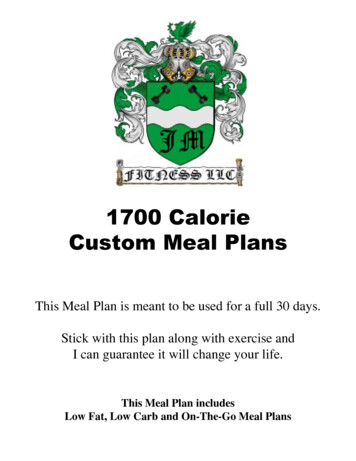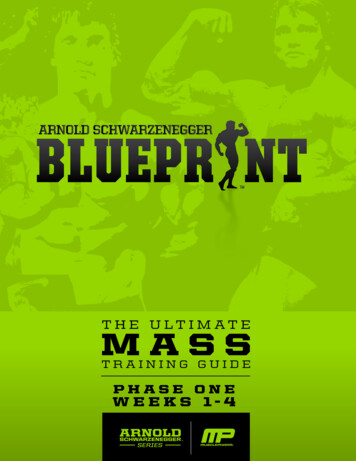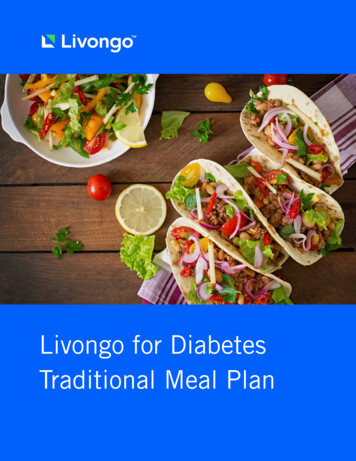
Transcription
Livongo for DiabetesTraditional Meal Plan
Welcome to the Livongo for DiabetesTraditional Meal PlanThe Livongo for Diabetes Traditional Meal Plan emphasizes moderatecarbohydrate intake, lean protein, healthy fats, fruits, and vegetables.Regulating carbohydrates has been shown to be effective in improving BG,as carb-heavy foods cause the largest rise in BG. You may have to adjust theamount of carbohydrates you eat if your BG remains outside of target on thisplan. This plan may also help to reduce the risk of diabetes complicationssuch as heart disease and stroke by lowering blood pressure and cholesterol.2
Table of ContentsNutrition and diabetes management are not the same for everyone. You maywant to eat better, lose weight, or improve BG—or work on all of these. Ourmeal plans take a four-part approach to guide you, step by step, towardachieving your goals. The four steps are:Mindful Eating:Gain awareness of how different foods taste, smell, and feel while you’reeating, and how they affect your mood, energy level, and hunger after eating.Understanding the Three Main Nutrients:Carbohydrates, proteins, and fatsLearning How the Nutrients Affect Your BG:Learn to use Paired Checking to keep track of how different foods affect your BG.Meal Planning:Mix and match from three food lists to create easy, well-balanced meals andsnacks. This section includes the following tools to help make planning a cinch:Meal Planning Basics: Green, Yellow, and Red Foods .16-17Color-Coded Food Lists.18-20Livongo for Diabetes Plate .21Quick Tips For Healthy Eating .22-233-Day Sample Meal Plan .24-26Sample List of Healthy Snacks.27Healthy Swaps .283
Before You BeginWe recommend reading through the entire plan before you begin. But, if youneed a quicker start, look at Meal Planning Basics: Green, Yellow, and RedFoods (pages 16-17), Color-Coded Food Lists (pages 18-20), and theLivongo for Diabetes Plate (page 21). Then, when you have more time, goback to read the rest of the plan.4
Next StepsAfter you’ve read the entire plan, if you still need extra help or havequestions, reach out to one of our Certified Diabetes Educators (CDEs) toschedule a coaching session at no cost to you, at coach.livongo.com.Stay Healthy!Your Coaching Team5
Mindful EatingIn Mindful Eating, unlike in traditional “dieting,” there are no good or badfoods. The idea is to be aware of which foods make you feel well and whichmake you feel unwell, either physically or emotionally.Mindful Eating is simply being fully present while eating: you’re smellingthe food, feeling the texture while chewing, and focusing all of your senseson enjoying the experience. Where we can get into trouble is when we eatfor pleasure without mindfulness. For example, you may sometimes eatmore than you need if you are distracted by watching television or reading.This is called mindless eating.Focusing on the sensation of eating and the feelings you have while eating,can help you control cravings and overeating—two things that can improveweight management, diabetes, blood pressure, and general health.6
Tips for Mindful Eating Instead of eliminating foods, start by adding healthy foods that make youfeel well. When you feel satisfied by nutritious foods, you might findyourself less likely to reach for less healthy foods. Listen to your body. Our bodies have ways to let us know that a food isgood for us. For example, healthy foods often energize you, whileunhealthy foods may make you feel sluggish. Use the scale below to help you figure out if you are hungry for a snack ora meal, or if you are eating for a reason other than hunger.7
Hunger-Satiety Rating ScaleFull10stuffed to the point of feeling sick9very uncomfortably full, feel the need to loosen your belt8uncomfortably full, feel stuffed7very full, feel as if you have overeaten6comfortably full, satisfied5comfortable, neither hungry nor full4beginning signs and symptoms of hunger3hungry with several hunger symptoms, ready to eat2very hungry, unable to concentrate1starving, dizzy, irritableNeutralHungry8
Questions to Ask Yourself to Avoid Mindless Eating Am I eating because I’m bored/nervous/upset or for some other reasonthat is not hunger? Do I ever get so busy that I don’t know I’m hungry until I’m starving andhave a headache—and then I overeat or choose ineffective foods? Do I clean my plate even when I get full before my plate is empty? If youranswer is “yes,” use a smaller plate. Aim for about nine inches. Forreference, a dollar bill is just over six inches long.9
Understanding the Three Main NutrientsFood can be divided into three basic nutrients: carbohydrates, proteins, andfats. Understanding how the body uses each nutrient and how each affectsBG will help you plan well-balanced meals. In turn, eating healthy will helpyou keep your BG stable and as close to goal as possible.CARBOHYDRATESPROTEINFATS10
CarbohydratesWhat are they? Carbohydrates are the sugars and starches that your bodybreaks down into glucose. They are found in grains, fruits, vegetables, milkproducts, and sweets.How they affect BG: The more carbohydrates you eat, the higher your BGwill be. The higher your BG is, the more insulin is needed in response.Insulin helps to lower glucose in the blood by sending the glucose to yourcells to be used for energy. If there is too much glucose in the blood stream,insulin will store the extra glucose as body fat.The goal: Carbohydrates are your body’s main source of energy. But not allcarbohydrates are the same. Choosing the right types of carbohydrates(fruits, vegetables, and high-fiber grains) will help give your body the energyit needs while keeping BG as close to goal as possible.11
ProteinWhat is it? Found in chicken, beef, eggs, fish, nuts, seeds, and beans,protein helps fill you up, and builds and maintains lean muscle.How does it affect BG? It stabilizes it. Because protein contains little to nocarbohydrate, it has a very small impact on BG.The goal: When choosing protein for your meals and snacks, you should optfor lean protein sources, as these contain less saturated fat. If selecting aplant-based protein, read the label closely as plant-based proteins oftencontain carbohydrates, which raise BG. Try to always include a protein wheneating a carbohydrate, because protein helps slow the rise of BG followingthe meal or snack.12
FatsWhat are they? Fats are a source of fuel for the body, and can even storeenergy. Fats also add great flavor and texture to food.How do fats affect BG? When eaten alone, fats will not raise your BG. Muchlike protein, fats can help keep you full and slow the absorption of sugar inyour bloodstream.The goal: In the past, fat has gotten a bad reputation. But healthyfats—monounsaturated fats (found in olive oil, avocados, nuts) andpolyunsaturated fats (found in sunflower oil, seeds, and fatty fish likesalmon)—have been shown to decrease the risk of heart disease. Whenchoosing fats, try to avoid trans fats, which have been shown to increase therisk of heart disease. These are found in some baked goods, crackers, andmargarine. Usually foods that contain trans fats will have “hydrogenated” or“partially hydrogenated” in the ingredient list.13
Learning How the Nutrients Affect Your BGAn important part of meal planning with diabetes is understanding whichfoods and meals help keep BG values as close to normal as possible. How doyou figure out which foods and meals are most effective? Paired Checking.14
What is Paired Checking?Paired Checking is checking your BG before and after a meal and/or activity.It shows the cause and effect relationship between BG levels and factorssuch as food and exercise.Before you start, think about what you want to learn about your BG? Hereare some ideas:1. How does packing my lunch instead of eating out affect my BG?2. How does one specific food affect my BG?3. How does a morning or evening workout affect my BG?4. I have a big presentation tomorrow. What effect will this have on my BG?5. What affects my fasting BG?What’s next? Let’s take numbers 1 and 2 as an example. Check your BGbefore you eat and then check again two hours after the first bite. (Alwayschecking as close to two hours as possible will help you get the bestresults.) Take a look and note how your BG varies. The next day, try adifferent food. Repeat the same pattern of checking. You will be able to seethe cause and effect on your numbers. How did your BG change? Thisprocess will help you identify how specific foods affect your BG. We suggestrepeating for seven days to identify a trend or pattern.The American Diabetes Association (ADA) recommends the following BG ranges:Pre-Meal Range: 80-130 mg/dlRange Two Hours After Beginning of a Meal: 80-180 mg/dlTalk with your physician to learn more about your individual BG goals.15
Meal Planning BasicsPlanning well-balanced meals can seem like a chore. To make mealplanning faster, easier, and even enjoyable, we provide three food lists fromwhich you can mix and match items to create healthy meals.To take the guesswork out of what goes into a well-balanced meal, wecategorized foods as green, yellow, or red. GREEN foods are always a go.YELLOW FOODS offer important nutrients but should be consumed in smallamounts. RED foods should be eaten rarely, as an occasional treat.Use the list to the right as a guide. If there are foods you don’t like, don’tforce yourself to eat them just because they are green foods. Or, try adifferent preparation—roast broccoli, instead of steaming it. Eat for healthand for pleasure.16
Green, Yellow, and Red FoodsGREENFoods in the green category have little to no effect on BG, provide the mostvitamins and minerals, and will fill you up and keep you full throughout theday. These are the foods you should choose most often when planningmeals. If you find you are still hungry after a meal and want seconds, theseare your go-to foods since they will satisfy your hunger without causing anadditional rise in BG. These are also the best foods to choose when BG iselevated at meal times.YELLOWFoods in the yellow category are still good choices but are likely to be higherin carbohydrates which can cause a higher rise in BG. Some of these foodsmay also be higher in saturated fat. Keep portions from this group small andlimit how many servings you include throughout the day. If you are unsure ofhow much and how often to include these foods, schedule an individualcoaching session at coach.livongo.com, at no cost to you.REDFoods in the red category are high in carbohydrate, high in both saturatedand trans fats, or have a low nutritional value. These foods will cause thehighest rise in BG after a meal or snack, and can cause weight gain. Thesefoods are best eaten as an occasional treat.t17
Green FoodsPROTEINSLean beefCanadian baconChicken without skinEggs/egg whitesFishPorkShellfishTurkeyOILS AND FATSAvocadosCanola oilOlive oilOlivesBEVERAGESBlack coffee (hot or iced)Bouillon or brothUnsweetened almond orcoconut milkUnsweetened tea (hot oriced)Water (plain, etsBroccoliBrussels plantGreen beansLeafy greens(lettuce, kale,collards, p peasCONDIMENTSHot sauce (lowsodium)MustardSalsaSrirachaSEASONINGSFresh and driedherbsGarlicLemon juiceLime juiceTomatoesWater chestnutsYellow squashZucchini18
Yellow angesPapayaPeachesPearsPineapplePlumsBREADS AND GRAINSBarleyBread (whole grainpreferred)Crackers (whole grainpreferred)CouscousEnglish muffins (wholewheat preferred)Pasta (whole wheatpreferred)Pita bread (whole wheatpreferred)Popcorn (air popped)QuinoaRice (brown or wildpreferred)Steel-cut oatsTortillas (corn preferred)STARCHY VEGETABLESCornParsnipsPeasPotatoesSweet potatoesSquash (acorn,butternut, spaghetti,etc.)TurnipsBEANSBlack beansBlack-eyedpeasGarbanzobeansKidney beansLentilsLima beansNavy beansPinto beansWhite ageCheeseGreek yogurt(plain)Milk (nonfat or1% preferred)Rice milkSoy milk(unsweetened)Yogurt (plainor light)NUTS ANDSEEDSAlmondsCashewsPeanutsPecansWalnutsNut buttersSeeds (flax,pumpkin,sunflower,etc.)OILS ANDFATSButterCoconut oilPeanut oilSafflower oilSunflower oilVegetable oilSWEETSANDDESSERTSDarkchocolate(72% cocoaand higher)19
Red FoodsFRUITSDried fruits(raisins,dates, etc.)Frozen fruitsw/added sugarFruits cannedin syrupGRAINSBagelsBiscuitsBuns (hotdogor hamburger)Cereal (dryand instant)CroissantsMuffinsPancakesRollsWafflesWhite flourBEANSBaked beansRefried beans(canned)PROTEINSBaconBeef (regularground beef, ribroast, pot roast)Chicken withskin and/orbreaded andfriedChorizoHot dogsPepperoniSausageSWEETS ANDDESSERTSBrowniesCakesCandy esDoughnutsFrozen yogurtIce creamPastriesPieSherbet/sorbetSoda/diet sodaSports drinksSweetened teaAny )Heavy creamCONDIMENTSAgaveBBQ sauceHoney pTeriyaki ck bars100-caloriepacksOILS AND FATSCream cheeseMargarineShorteningSour cream20
Livongo for Diabetes PlateFATPROTEINCARBSNON-STARCHYVEGETABLES21
Quick Tips for Healthy EatingCheck BG more often. When you change what and how you eat,even if it’s for the better, it is important to check BG morefrequently to see how these changes are affecting your BG.Drink plenty of water. Early signs of dehydration (headache,dizziness, and feeling tired) are often mistaken for hunger, andcan lead to unnecessary snacking. Try to drink eight to teneight-ounce glasses of water per day.Still hungry after a meal? Eat more non-starchy vegetables. If youfind you want seconds after finishing a meal, eat morenon-starchy vegetables like leafy greens, broccoli, and peppers.These will have a very low effect on your BG, and they containfiber which will help you feel fuller faster.Keep healthy, low-carb snacks on hand. Stock up on items likenuts, beef jerky, cut raw vegetables, fruit, and nut butters.22
Quick Tips for Healthy Eating31Plan and prepare meals in advance. Set aside time each week towash and chop vegetables, trim and prepare proteins, and cookitems like soups and casseroles for the week ahead.Always include protein. Protein keeps you full and satisfied,builds lean muscle, and has very little impact on BG. Aim forthree to four ounces (about the size of your palm) of protein ateach meal.Include healthy fats at each meal. Healthy fats keep yousatisfied, help decrease hunger, and slow the absorption of sugarin your bloodstream.Know your portion sizes. We often don’t realize that we overeatbecause we don’t know what a portion size looks like. Becomefamiliar with common portion sizes to be sure you are eatingcarbohydrates, protein, and fats in the right amounts.23
3 Day Sample Meal Plan: Day OneBREAKFAST1 whole-wheat English muffin with 2 turkey slices, 1 ouncemelted low-fat cheese, tomato slices, and 1/4 avocado. 1 smallorange or apple.LUNCH1 cup lentil soup. 6 whole-grain crackers. 1/2 cup tuna orchicken salad with carrot and celery sticks, and tomato slices.DINNER1 cup steamed red potatoes. 1 cup cooked broccoli. 3-4 ouncesgrilled chicken, fish, or lean meat. 1 cup strawberries.SNACK3 graham cracker squares. 1 tablespoon no-sugar-added nutbutter.24
3 Day Sample Meal Plan: Day TwoBREAKFAST2-egg veggie omelet with spinach, onions, bell peppers, andmushrooms. 2 slices of whole-wheat toast. 1 teaspoon butter. 1slice Canadian bacon. 1/2 banana.LUNCHGrilled chicken Caesar salad with romaine lettuce, 3-4 ouncesskinless chicken breast, 1 tablespoon grated Parmesan cheese,1/2 cup of croutons and 1 tablespoon low-fat dressing. 1 smallpear. 1/2 cup cottage cheese.DINNER1 cup cooked pasta with 3-4 ounces meatballs and 1/2 cupmarinara sauce. Steamed cauliflower and zucchini.SNACKNonfat Greek yogurt25
3 Day Sample Meal Plan: Day ThreeBREAKFAST1 cup cooked oatmeal (not instant) with 1/2 banana, 2tablespoon almonds, and cinnamon.LUNCH2 slices of whole-wheat bread, 3 ounces Turkey slices, lettuce,tomato, and onion slices, mustard, 1 ounce low-fat cheese (forexample, part-skim mozzarella). 1 cup grapes.DINNER2 chicken or ground turkey tacos: 2 corn tortillas, 3-4 ouncesmeat, lettuce, tomato, onion, salsa, ¼ cup of shredded cheese.1/2 cup black or pinto beans. Green salad with 1 tablespoonlow-fat dressing. Unsweetened ice tea with lemon.SNACK3 cups air-popped popcorn. 1 ounce string cheese.26
Sample List of Healthy SnacksWell-balanced snacks can help limit a rise in BG between meals, and avoidthe mindless eating that sometimes happens when we get so hungry thatwe, say, scarf down a sleeve of cookies, instead of preparing a healthy meal.Be mindful of your portions—it’s easy for a snack to grow into a meal! Belowyou will find a sample list of zero- and low-carbohydrate snacks. 1 ounce string cheese, TheLaughing Cow cheese, or othercheese 1/4 avocado with salsa 1/4 cup nuts or seeds 3 ounces leftover chickenbreast or salmon small piece of fruit (for example,an apple, orange, or pear) 2 tablespoons pumpkin seeds 5-6 olives (green or black)* hard-boiled egg 1 large dill pickle* celery with 1-2 tablespoonsno-added-sugar nut butter orcream cheese 1 serving of beef or turkeyjerky* 1/2 cup tuna or chicken salad cottage cheese 1 slice of lean lunch meat (turkey,ham) rolled around a 1 stringcheese raw vegetables with 1 tablespoonhummus steamed vegetables (except forstarch-heavy veggies like peas,corn, beans, potatoes, and sweetpotatoes) cucumber or tomato sliceswith lemon and hot sauce green salad without croutonsor beans sugar-free Jell-O or sugar-freepopsicle (check labels to findone with less than 5 gramscarbs)*may have high sodium content27
Healthy SwapsINSTEAD OF THIS TRY THISSandwich breadHearty leafy greens(chard, kale,lettuce, etc.)Mashed potatoesMashed cauliflowerCroutonsWalnutsMayonnaiseMashed avocadoPastaSpaghetti squashSour creamPlain Greek yogurt28
Support When You Need ItWe’re here to help you 24 hours a day, 365 days a year. For any questionsabout the Livongo for Diabetes Program, the meter, or supply refills pleasereach out to Livongo Member Support at 1-800-945-4355 ormembersupport@livongo.com. Our team of Certified Diabetes Educators arealso available at any time to answer your diabetes questions on nutrition orlifestyle changes. You can communicate with coaches through our mobileapp or schedule a coaching session at coach.livongo.com.Copyright 2016 Livongo Health, Inc.All Rights Reserved.
This plan may also help to reduce the risk of diabetes complications . Use the scale below to help you figure out if you are hungry for a snack or a meal, or if you are eating for a reason other than hunger. 7. . contain carbohydrates, which raise BG. Try to always include a protein w

